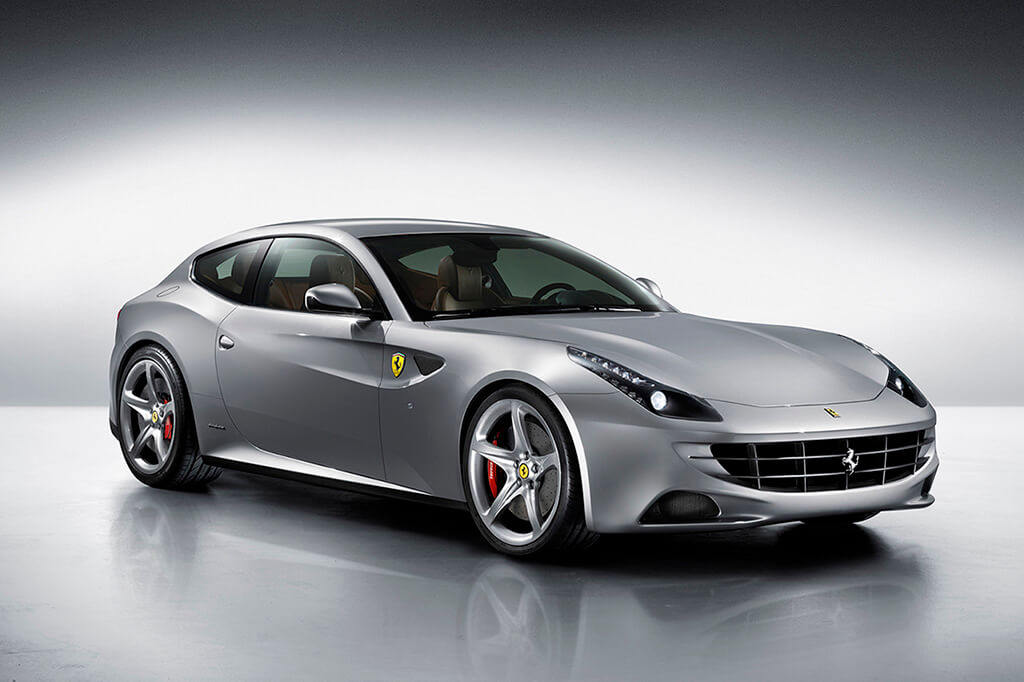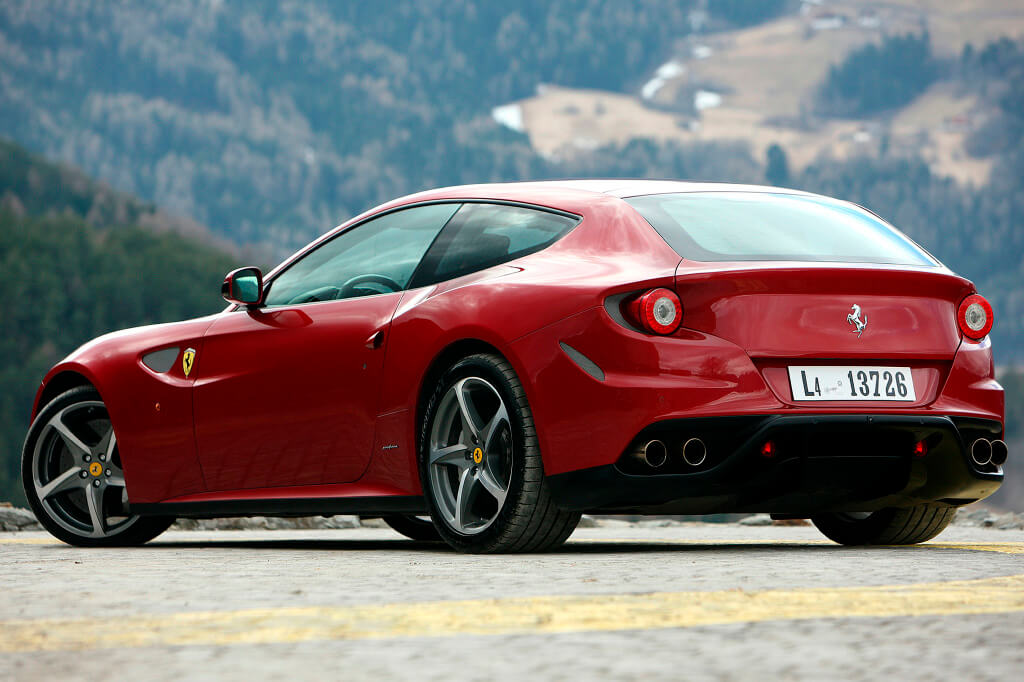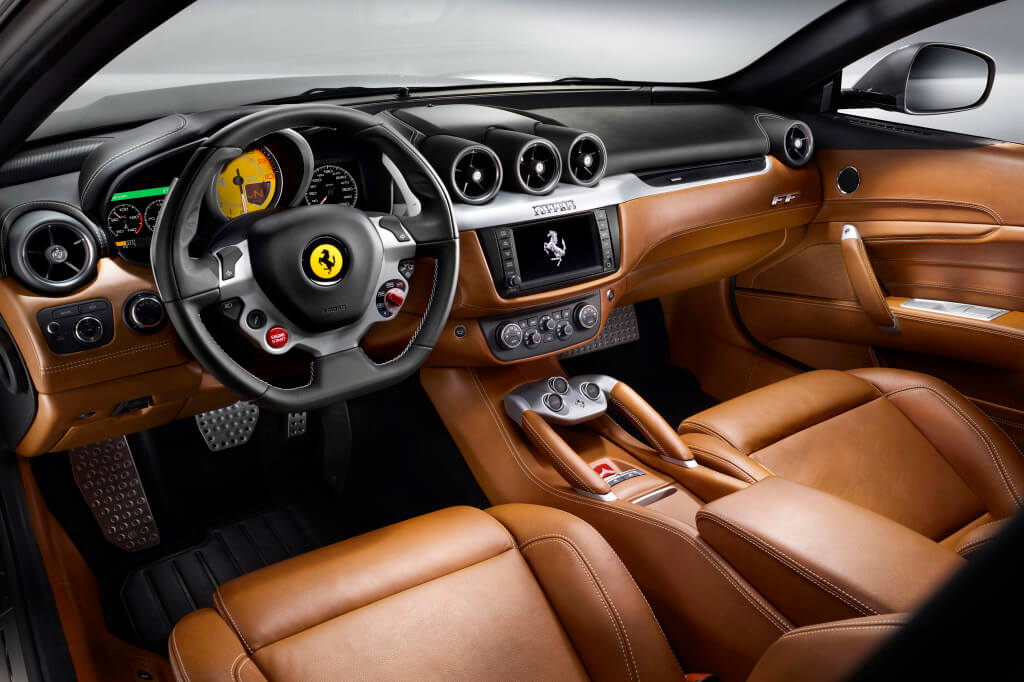Ferrari FF
| Successor: |
|---|
Description
On January 21, 2011, Ferrari introduced the FF model (FF stands for “Ferrari Four”, that is, four seats and four driven wheels) – a Gran Turismo class supercar. The official premiere took place on March 1, 2011 at the 81st International Motor Show in Geneva. The supercar replaced the Ferrari 612 Scaglietti, and it was replaced in 2016 by the Ferrari GTC4Lusso.
This model had two fundamentally new features for cars produced in Maranello – it was the first all-wheel drive Ferrari car, and the first supercar with a hatchback body (shooting brake). The body was developed under the direction of Lowy Vermeersch, former design director at Pininfarina, and Flavio Manzoni, Ferrari Style Center. Work on the shooting brake concept began after the creation of the Sintesi show car in 2007. Such a body provided the convenience of transforming the interior with a stylish appearance.
The cost of the Ferrari FF was about 300,000 USD.
Engine
The Ferrari FF used the largest engine ever produced by the company at that time - a naturally aspirated V12 with a cylinder angle of 65° and a displacement of 6.3 liters. This unit produced 660 hp. (485 kW) at 8000 rpm and torque – 683 Nm at 6000 rpm. Average fuel consumption was just 15.4 liters per 100 km and CO2 emissions were 360 g/km, a 25% reduction compared to previous V12 engines, thanks in part to the HELE (High Emotions) system, which included Stop&Start technology.
Transmission
The supercar was equipped with a 7-speed dual-clutch DCT automatic transmission, similar to those found on the Ferrari California and Ferrari 458 Italia.
The new all-wheel drive system developed and patented by Ferrari was called 4RM. It was 50% lighter than a conventional similar system. The front wheels were connected through a separate two-speed gearbox (weighed 35 kg, gears and other components were made by Carraro Engineering) with a dual clutch, which received power from the front of the engine. This transmission (designated a Power Transfer Unit PTU) had only two forward gears (2nd and 4th) plus reverse (with ratios 6% higher than the corresponding final drive ratios). gearbox), so the system was only active from 1st to 4th gears. The connection between this gearbox and each front wheel is carried out through independent Haldex-type clutches, without a differential. Due to the difference in gear ratios, “the clutches constantly slipped” and transmitted no more than 20% of the engine torque. In the top three gears (V, VI, VII) only the rear wheels were driven. Front-wheel drive was only engaged when the drive mode switch was set to Comfort or Snow, the rest of the time the car remains traditionally rear-wheel drive. The 4RM name had already been used by Ferrari on two all-wheel drive prototypes in the 1980s (for example, in the 408 4RM is an acronym for “4.0 litre, 8 cylinder, 4 Ruote Motrici”, meaning “all-wheel drive”). However, all-wheel drive was abandoned at that time after extensive testing.
Dynamics
The maximum speed of the Ferrari FF was 335 kph, and acceleration from zero to 100 kph was 3.6 seconds. Ferrari positioned the FF as the fastest all-wheel drive car in the world.
Suspension
The supercar's suspension was independent at the front - on double wishbones, at the rear - multi-link with electronically adjustable magnetic-rheological Delphi shock absorbers and anti-roll bars. The curb weight was 1880 kg and was distributed between the axles in a ratio of 49% at the front and 51% at the rear.
Brake system
The ceramic braking system was developed by Brembo.
Exterior
The supercar was designed in such a way that it was immediately unmistakably recognizable as a modern Ferrari model. The headlights were almost identical to those of the Ferrari 458 Italia. There were four exhaust pipes, like the Ferrari 599 GTB Fiorano, and a large oval grille. The kinship with the 458 model is also visible in the design of the lower skirts of the body side panels. The overall design of the model was in keeping with the spirit of the famous 1962 supercar Ferrari 250 GT Drogo. The FF's external design provided a drag coefficient of Cx=0.329.
The combination of hatchback and station wagon designs, coupled with collapsible rear seats, made it possible to change the trunk volume ranging from 450 to 800 liters.
Interior
The interior was upholstered in Poltrona Frau leather, available in six colors, and the seats could be trimmed in a different color around the edges. There was also carpeting, climate control, and a GPS navigation system. Separately worthy of mention is the multimedia system with two screens with the ability to view TV and DVD in the headrests of the front seats and a 16-channel stereo system with a power of 1280 W with Quantumlogic Surround Sound technology.
It was possible to order additional options for an additional fee. The carbon steering wheel with LED inserts, which appeared on the Scuderia model, was offered for 5,500 euros. Carbon inserts cost from 5,526 to 21,265 euros, luggage for 10,166 euros.
Sources
Specification
| Bodywork | |
|---|---|
| Presentation | |
| Years of production |
2011-2016
|
| Body type |
шутинг брейк
|
| Number of doors |
3
|
| Number of places |
2+2
|
| Engine | |
|---|---|
| Engine type |
бензиновый
|
| Engine location |
спереди, продольное
|
| Engine model |
Ferrari Tipo F140 EB 65º V12
|
| Cylinders |
V12
|
| V-angle |
65°
|
| Capacity (cc) |
6262
|
| Power output (hp / kW /) |
660 /
485 /
|
| at rpm |
8000
|
| Torque (N·m) |
683
|
| at rpm |
6000
|
| Redline (rpm) |
8000
|
| Bore (mm) |
94,0
|
| Stroke (mm) |
75,2
|
| Compression |
12,3
|
| Number of valves |
4/48
|
| Valvetrain |
DOHC
|
| Block material |
алюминиевый сплав
|
| Oil sump capacity (l) |
13,0
|
| Cooling volume (l) |
16,9
|
| Fuel system |
прямой впрыск
|
| Turbocharger |
—
|
| Specific | |
|---|---|
| Specific output (hp/litre) |
105,40
|
| Specific output (hp/tonne) |
351,06
|
| Specific output (kg/hp) |
2,85
|
| Specific torque (N·m/litre) |
109,07
|
| Specific torque (N·m/tonne) |
363,30
|
| Transmission | |
|---|---|
| Driven wheels |
полный
|
| Clutch |
двухдисковое
|
| Gearbox model |
Magna (Getrag) 7DCL750
|
| Gearbox |
роботизированная
|
| Number of speeds |
7
|
| Final drive ratio |
3,880
|
| First gear ratio |
3,397
|
| Second gear ratio |
2,186
|
| Third gear ratio |
1,626
|
| Fourth gear ratio |
1,285
|
| Fifth gear ratio |
1,029
|
| Sixth gear ratio |
0,839
|
| Seventh gear ratio |
0,634
|
| Reverse gear ratio |
2,791
|
| Suspension | |
|---|---|
| Front suspension |
независимая на двойных поперечных рычагах
|
| Rear suspension |
независимая многорычажная
|
| Elastic elements in front |
пружины
|
| Elastic elements in rear |
пружины
|
| Front anti-roll bar | |
| Rear anti-roll bar | |
| Wheel size front |
8,5J×20
|
| Wheel size rear |
10,5J×20
|
| Tire brand |
Michelin
|
| Tyres front |
245/35 R20
|
| Tyres rear |
295/35 R20
|
| Steering | |
|---|---|
| Steering type |
шестерня-рейка
|
| Power steering |
электрический
|
| Brakes specs | |
|---|---|
| Brakes front |
дисковые вентилируемые перфорированные
|
| Brakes rear |
дисковые вентилируемые перфорированные
|
| Brand of brakes |
Brembo
|
| Front brake diameter (mm) |
398×38
|
| Rear brake diameter (mm) |
360×32
|
| Disc material |
карбон-керамика
|
| Anti-lock braking system |
да
|
| Dimensions and weight | |
|---|---|
| Body |
алюминиевый трубчатый каркас
|
| Body material |
углеволокно, алюминий
|
| Length (mm) |
4907
|
| Width (mm) |
1953
|
| Height (mm) |
1379
|
| Wheelbase (mm) |
2990
|
| Front track (mm) |
1676
|
| Rear track (mm) |
1660
|
| Ground clearance (mm) |
145
|
| Drag coefficien |
0,329
|
| Dry weight (kg) |
1790
|
| Curb weight (kg) |
1880
|
| Max. weight (kg) |
2320
|
| Trunk volume min (litre) |
450
|
| Trunk volume max (litre) |
800
|
| Weight distribution (%) |
49/51
|
| Performance specs | |
|---|---|
| Ecological class |
Евро 5
|
| CO₂ emissions (NEDC) (g/km) |
360
|
| Fuel consumption (EC) highway (l/100 km) |
10,7
|
| Fuel consumption (EC) city (l/100 km) |
23,5
|
| Fuel consumption (EC) combined (l/100 km) |
15,4
|
| Fuel consumption (EPA) highway (l/100 km) |
13,1
|
| Fuel consumption (EPA) city (l/100 km) |
21,4
|
| Fuel tank capacity (l) |
91
|
| Fuel type |
Аи-98
|
| Dynamic specs | |
|---|---|
| Acceleration 0-10 kph (s) |
0,3
|
| Acceleration 0-20 kph (s) |
0,6
|
| Acceleration 0-30 kph (s) |
0,9
|
| Acceleration 0-40 kph (s) |
1,2
|
| Acceleration 0-50 kph (s) |
1,5
|
| Acceleration 0-60 kph (s) |
1,8
|
| Acceleration 0-70 kph (s) |
2,2
|
| Acceleration 0-80 kph (s) |
2,6
|
| Acceleration 0-90 kph (s) |
3,0
|
| Acceleration 0-100 kph (s) |
3,6
|
| Acceleration 0-110 kph (s) |
4,0
|
| Acceleration 0-120 kph (s) |
4,4
|
| Acceleration 0-130 kph (s) |
4,7
|
| Acceleration 0-140 kph (s) |
5,1
|
| Acceleration 0-150 kph (s) |
5,5
|
| Acceleration 0-160 kph (s) |
6,1
|
| Acceleration 0-170 kph (s) |
6,8
|
| Acceleration 0-180 kph (s) |
7,9
|
| Acceleration 0-190 kph (s) |
9,2
|
| Acceleration 0-200 kph (s) |
11,0
|
| Acceleration 0-210 kph (s) |
13,2
|
| Acceleration 0-220 kph (s) |
16,1
|
| Acceleration 0-230 kph (s) |
19,4
|
| Acceleration 0-240 kph (s) |
23,1
|
| Acceleration 0-250 kph (s) |
26,9
|
| Acceleration 0-260 kph (s) |
30,6
|
| Acceleration 0-270 kph (s) |
34,1
|
| Acceleration 0-280 kph (s) |
37,3
|
| Acceleration 0-290 kph (s) |
39,9
|
| Acceleration 0-300 kph (s) |
41,9
|
| Acceleration 0-10 mph (s) |
0,5
|
|---|---|
| Acceleration 0-20 mph (s) |
1,0
|
| Acceleration 0-30 mph (s) |
1,5
|
| Acceleration 0-40 mph (s) |
2,0
|
| Acceleration 0-50 mph (s) |
2,6
|
| Acceleration 0-60 mph (s) |
3,5
|
| Acceleration 0-70 mph (s) |
4,1
|
| Acceleration 0-80 mph (s) |
4,7
|
| Acceleration 0-90 mph (s) |
5,3
|
| Acceleration 0-100 mph (s) |
6,1
|
| Acceleration 0-110 mph (s) |
7,5
|
| Acceleration 0-120 mph (s) |
9,7
|
| Acceleration 0-130 mph (s) |
13,0
|
| Acceleration 0-140 mph (s) |
17,8
|
| Acceleration 0-150 mph (s) |
23,6
|
| Acceleration 0-160 mph (s) |
29,7
|
| Acceleration 0-170 mph (s) |
35,3
|
| Acceleration 0-180 mph (s) |
39,9
|
| Acceleration 0-92 m (300 feet) (s) /kph/ |
5,0 /
127,0 /
|
|---|---|
| Acceleration 0-100 m (s) /kph/ |
5,2 /
132,0 /
|
| Acceleration 0-200 m (s) /kph/ |
7,8 /
169,0 /
|
| Acceleration 0-201 m (1/8 mile) (s) /kph/ |
7,9 /
169,0 /
|
| Acceleration 0-300 m (s) /kph/ |
9,8 /
191,0 /
|
| Acceleration 0-305 m (1000 feet) (s) /kph/ |
9,9 /
192,0 /
|
| Acceleration 0-400 m (s) /kph/ |
11,6 /
206,0 /
|
| Acceleration 0-402 m (1/4 mile) (s) /kph/ |
11,7 /
206,0 /
|
| Acceleration 0-500 m (s) /kph/ |
13,4 /
220,0 /
|
| Acceleration 0-600 m (s) /kph/ |
15,2 /
231,0 /
|
| Acceleration 0-610 m (2000 feet) (s) /kph/ |
15,4 /
232,0 /
|
| Acceleration 0-700 m (s) /kph/ |
16,9 /
241,0 /
|
| Acceleration 0-800 m (s) /kph/ |
18,6 /
250,0 /
|
| Acceleration 0-805 m (1/2 mile) (s) /kph/ |
18,7 /
250,0 /
|
| Acceleration 0-900 m (s) /kph/ |
20,2 /
257,0 /
|
| Acceleration 0-914 m (3000 feet) (s) /kph/ |
20,5 /
258,0 /
|
| Acceleration 0-1000 m (s) /kph/ |
21,8 /
263,0 /
|
| Acceleration 0-1067 m (3500 feet) (s) /kph/ |
22,9 /
267,0 /
|
| Acceleration 0-1100 m (s) /kph/ |
23,4 /
268,0 /
|
| Acceleration 0-1200 m (s) /kph/ |
24,9 /
273,0 /
|
| Acceleration 0-1219 m (4000 feet) (s) /kph/ |
25,2 /
274,0 /
|
| Acceleration 0-1300 m (s) /kph/ |
26,3 /
276,0 /
|
| Acceleration 0-1400 m (s) /kph/ |
27,8 /
279,0 /
|
| Acceleration 0-1500 m (s) /kph/ |
29,1 /
282,0 /
|
| Acceleration 0-1610 m (1 mile) (s) /kph/ |
30,6 /
285,0 /
|
| Braking distance 100-0 kph (m) |
35
|
|---|
| Top speed (kph) |
335
|
|---|---|
| Top speed (mph) |
208
|



